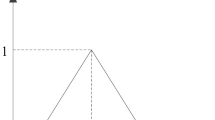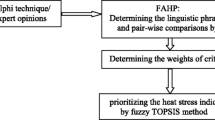Abstract
Working in hot and humid environments can jeopardize the health and safety of the workers and reduce their efficiency. Different physical, environmental, and human factors can influence the risk level of working in these atmospheres. Therefore, the risk assessment of such atmospheres must be carried out from a holistic point of view. This paper aims to introduce a novel risk assessment and prioritization model, using hybrid AHP and VIKOR methods in a fuzzy environment. The AHP method was adopted to determine the importance (weight) of the risk influencing parameters. Also, the VIKOR as a compromise solution method was applied to rank the different working stations against the risk criteria. Fuzzy set theory was used to handle the inherent ambiguity and vagueness of the data encountered in the evaluation process. Furthermore, the fuzzy TOPSIS was adopted to further represent the efficacy of the proposed model. To demonstrate the applicability of the model, a small size foundry shop was selected as the real case and a sensitivity analysis was performed to confirm the validity of the model. The results revealed that the “Environment” has the most contribution to the risk level of hot environments (WE = 0.615). That is followed by “Temperature” (WDBT = 0.268), “Air velocity” (WAV = 0.170), “Safety training” (WST = 0.161), “Mean radiant intensity” (WMRT = 0.110), “Humidity” (WH = 0.066), “Seniority structure” (WSS = 0.063), “Work intensity” (WWI = 0.058), “PPE” (WPPE = 0.047), “Work nature” (WPPE = 0.034), and “ Work duration” (WT = 0.022), in sub-factors. Using the F-VIKOR method, the “melting furnace” workstation was determined as the compromise solution with the index value of Q = 1.



Similar content being viewed by others
Abbreviations
- TpFN:
-
Trapezoid fuzzy number
- \(L_{p,j}\) :
-
Distance of the alternative Aj from the best ideal solution
- \(w_{j}\) :
-
Weight (relative importance) of jth criterion
- \(f_{ij}\) :
-
Measured score of the jth alternative (Aj) against the ith criteria (Ci)
- \(f_{j}^{*}\) :
-
The best values of all criterion ratings
- \(f_{j}^{ - }\) :
-
The worst values of all criterion ratings
- \(\mu_{{\tilde{A}}} \left( x \right)\) :
-
Membership function of a TpFN
- L, m, n, u :
-
Lower, mide, and upper numbers of the fuzzy set
- \(\tilde{A}\), \(\tilde{B}\) :
-
Two positive TpFNs
- \(\oplus , \ominus, \otimes , { \oslash }\) :
-
Addition, Subtraction, Multiplication, and Division operators of TpFNs
- \(\tilde{a}\) :
-
Pair-wise comparison matrices of the criteria
- \(a_{ij}^{k}\) :
-
Fuzzy rating of the kth decision-maker
- \(\tilde{a}_{ij}\) :
-
Aggregated fuzzy ratings (\(\tilde{a}_{ij}\)) of criteria
- CI:
-
Consistency index
- RI:
-
Random index
- CR:
-
Consistency ratio
- \(\lambda_{\max }\) :
-
Largest eigenvalue of the matrix
- \(\alpha , \beta , \gamma ,\delta\) :
-
Geometric mean of the lower, middle, and upper numbers of the fuzzy number
- \(\tilde{W}\) :
-
Fuzzy weight vector
- \(\tilde{w}_{j}\) :
-
Indicators weights
- \((\tilde{x}_{ijk} )\) :
-
Aggregated fuzzy rating of evaluation
- \(\tilde{D}\) :
-
Decision matrix
- \(defuzz \left( {xij} \right)\) :
-
Defuzzified values of the decision matrix
- \(defuzz \left( {wj} \right)\) :
-
Defuzzified values of the fuzzy weights
- S i, R i :
-
Mean group utility and maximum regret values
- Q:
-
Index value
- \(\upsilon\) :
-
Weight of the maximum group utility (weight of the strategy)
- 1 – ν:
-
Weight of individual regret
References
Akram M, Al-Kenani AN, Alcantud JCR (2019) Group decision-making based on the VIKOR method with trapezoidal bipolar fuzzy information. Symmetry 11(10):1313
Akyuz E, Celik E (2015) A fuzzy DEMATEL method to evaluate critical operational hazards during gas freeing process in crude oil tankers. J Loss Prev Process Ind 38:243–253
Ayağ Z, Özdemir RG (2006) A fuzzy AHP approach to evaluating machine tool alternatives. J Intell Manuf 17(2):179–190
Bethea D, Parsons K 0(2002) Health and safety executive staff. Development of a Practical Heat Stress Assessment Methodology for Use in UK Industry. HSE Books, London
Binazzi A, Levi M, Bonafede M, Bugani M, Messeri A, Morabito M, Baldasseroni A (2019) Evaluation of the impact of heat stress on the occurrence of occupational injuries: meta-analysis of observational studies. Am J Ind Med 62(3):233–243
Brake R, Bates G (2002) A valid method for comparing rational and empirical heat stress indices. Ann Occup Hyg 46(2):165–174
Chong D, Zhu N, Luo W, Zhang Z, Pan X (2020) Effects of heat acclimation on individual safety performance in hyperthermal indoor environments. Build Environ 168:106537
Csutora R, Buckley JJ (2001) Fuzzy hierarchical analysis: the Lambda-Max method. Fuzzy Sets Syst 120(2):181–195
DHSS. (2018). NIOSH criteria for a recommended standard: occupational exposure to heat and hot environments: National Institute on Drug Abuse.
Dong XS, West GH, Holloway-Beth A, Wang X, Sokas RK (2019) Heat-related deaths among construction workers in the United States. Am J Ind Med 62(12):1047–1057. https://doi.org/10.1002/ajim.23024
Gasparrini A, Guo Y, Hashizume M, Lavigne E, Zanobetti A, Schwartz J, Armstrong B (2015) Mortality risk attributable to high and low ambient temperature: a multicountry observational study. The Lancet 386(9991):369–375. https://doi.org/10.1016/S0140-6736(14)62114-0
Ghosh A, Kar SK (2018) Application of analytical hierarchy process (AHP) for flood risk assessment: a case study in Malda district of West Bengal India. Nat Hazards 94(1):349–368
Golbabaei F, Omidvar M, Nirumand F (2019a) Risk assessment of heat stress using the AHP and TOPSIS methods in fuzzy environment: a case study in a foundry shop. J Health Safety Work 8(4):397–408
Hansen AL, Williams S, Hanson-Easey S, Varghese BM, Bi P, Heyworth J, Pisaniello DL (2020) Using a qualitative phenomenological approach to inform the etiology and prevention of occupational heat-related injuries in Australia. Int J Environ Res Public Health 17(3):846
Ilangkumaran M, Karthikeyan M, Ramachandran T, Boopathiraja M, Kirubakaran B (2015) Risk analysis and warning rate of hot environment for foundry industry using hybrid MCDM technique. Saf Sci 72:133–143. https://doi.org/10.1016/j.ssci.2014.08.011
Inaba R, Mirbod SM (2007) Comparison of subjective symptoms and hot prevention measures in summer between traffic control workers and construction workers in Japan. Ind Health 45(1):91–99
International Organization for Standardization (2004) ISO 7933:2004, Ergonomics of the thermal environment—analytical determination and interpretation of heat stress using calculation of the predicted heat strain. Geneva, Switzerland.
International Organization for Standardization (2017) 7243 Ergonomics of the thermal environment—assessment of heat stress using the WBGT (Wet Bulb Globe Temperature) Index (ISO 7243: 2017). In International Organization for Standardization: Geneva, Switzerland
Khashei-Siuki A, Sharifan H (2020) Comparison of AHP and FAHP methods in determining suitable areas for drinking water harvesting in Birjand aquifer Iran. Groundwater Sustain Dev 10:100328
Kjellstrom T, Briggs D, Freyberg C, Lemke B, Otto M, Hyatt O (2016) Heat, human performance, and occupational health: a key issue for the assessment of global climate change impacts. Annu Rev Public Health 37:97–112
Lee H-C, Chang C-T (2018) Comparative analysis of MCDM methods for ranking renewable energy sources in Taiwan. Renew Sustain Energy Rev 92:883–896
Li RYM, Wing CK, Zeng F (2019) Ranking of risks for the existing and new building works. Sustainability 11:2863. https://doi.org/10.3390/su11102863
Liu H-C, Liu L, Liu N, Mao L-X (2012) Risk evaluation in failure mode and effects analysis with extended VIKOR method under fuzzy environment. Expert Syst Appl 39(17):12926–12934. https://doi.org/10.1016/j.eswa.2012.05.031
Lyu H-M, Zhou W-H, Shen S-L, Zhou A-N (2020) Inundation risk assessment of metro system using AHP and TFN-AHP in Shenzhen. Sustain Cities Soc 56:102103
Martínez-Solanas È, López-Ruiz M, Wellenius GA, Gasparrini A, Sunyer J, Benavides FG, Basagaña X (2018) Evaluation of the impact of ambient temperatures on occupational injuries in Spain. Environ Health Perspect 126(6):067002
Nasseri, H. (2008). Fuzzy numbers: positive and nonnegative. Paper presented at the International Mathematical Forum.
Omidvar M, Mazloumi A, Mohammad Fam I, Nirumand F (2017) Development of a framework for resilience measurement: Suggestion of fuzzy Resilience Grade (RG) and fuzzy Resilience Early Warning Grade (REWG). Work 56(3):463–474
Omidvar M, Nirumand F (2017) An extended VIKOR method based on entropy measure for the failure modes risk assessment–A case study of the geothermal power plant (GPP). Saf Sci 92:160–172
Opricovic S, Tzeng GH (2007) Extended VIKOR method in comparison with outranking methods. Eur J Res 178(2):514–529
Opricovic S, Tzeng G-H (2004) Compromise solution by MCDM methods: A comparative analysis of VIKOR and TOPSIS. Eur J Oper Res 156(2):445–455
Parsons K (2019) Human heat stress. CRC Press
Prevention CFDC (2008) Heat-related deaths among crop workers-United States, 1992--2006. MMWR Morbidity and Mortality Weekly Report 57(24):649–653
Saaty TL (2008) Decision making with the analytic hierarchy process. Int J Serv Sci 1(1):83–98
Samaniego-Rascón D, da Silva MCG, Ferreira AD, Cabanillas-Lopez RE (2019) Solar energy industry workers under climate change: a risk assessment of the level of heat stress experienced by a worker based on measured data. Saf Sci 118:33–47
Shemshadi A, Shirazi H, Toreihi M, Tarokh MJ (2011) A fuzzy VIKOR method for supplier selection based on entropy measure for objective weighting. Expert Syst Appl 38(10):12160–12167
Spector JT, Masuda YJ, Wolff NH, Calkins M, Seixas N (2019) Heat exposure and occupational injuries: review of the literature and implications. Curr Environ Health Rep 6(4):286–296
Swaen GMH, Van Amelsvoort LGPM, Bültmann U, Kant IJ (2003)0 Fatigue as a risk factor for being injured in an occupational accident: results from the Maastricht Cohort Study. Occupat Environ Med 60 (Suppl 1), i88–i92. https://doi.org/10.1136/oem.60.suppl_1.i88
Wang F, Kuklane K, Gao C, Holmér I (2010) Can the PHS model (ISO7933) predict reasonable thermophysiological responses while wearing protective clothing in hot environments? Physiol Meas 32(2):239–249. https://doi.org/10.1088/0967-3334/32/2/007
Zadeh LA (1965) Fuzzy sets. Inf Control 8(3):338–353
Zhang S, Zhu N, Lv S (2021) Human response and productivity in hot environments with directed thermal radiation. Build Environ 187:107408. https://doi.org/10.1016/j.buildenv.2020.107408
Zheng G, Zhu N, Tian Z, Chen Y, Sun B (2012) Application of a trapezoidal fuzzy AHP method for work safety evaluation and early warning rating of hot and humid environments. Saf Sci 50(2):228–239. https://doi.org/10.1016/j.ssci.2011.08.042
Acknowledgments
This research has been supported by Bushehr University of Medical Sciences, Iran (Grant No. BPUMS-213H-20).
Author information
Authors and Affiliations
Corresponding author
Ethics declarations
Conflict of interest
The authors declare that they have no known competing financial interests or personal relationships that could have appeared to influence the work reported in this paper.
Additional information
Publisher's Note
Springer Nature remains neutral with regard to jurisdictional claims in published maps and institutional affiliations.
Supplementary Information
Below is the link to the electronic supplementary material.
Rights and permissions
About this article
Cite this article
Ramavandi, B., Darabi, A.H. & Omidvar, M. Risk assessment of hot and humid environments through an integrated fuzzy AHP-VIKOR method. Stoch Environ Res Risk Assess 35, 2425–2438 (2021). https://doi.org/10.1007/s00477-021-01995-1
Accepted:
Published:
Issue Date:
DOI: https://doi.org/10.1007/s00477-021-01995-1




